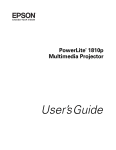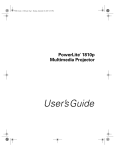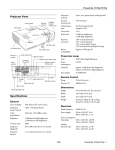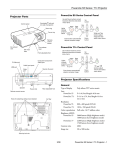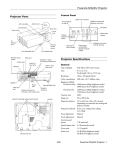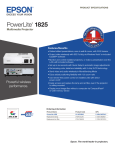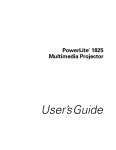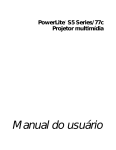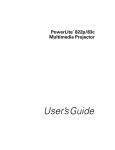Download Epson PowerLite 1825 Specifications
Transcript
PowerLite 1825 Projector Parts Specifications General CF Card reader Focus ring Zoom ring Control panel A/V mute slide Lamp cover Remote receiver Air exhaust vent Speaker Foot adjust lever Wireless module Monitor out port USB port type B Type of display Poly-silicon TFT active matrix Resolution (native format) 1024 × 768 pixels (XGA) Color reproduction Full color, 16.8 million colors Brightness 3500 lumens (high brightness) 2700 lumens (low brightness) Contrast ratio 500:1 Image size (diagonal) 30 to 300 inches (76.2 to 762 centimeters) Projection distance 2.7 to 48.2 feet (0.8 to 14.7 meters) Projection methods Front, rear, front ceiling, rear ceiling Internal sound system 5 W monaural Optical aspect ratio 4:3 (horizontal:vertical) (supports 16:9) Zoom ratio 1:1.6 Noise level 32 dB (low brightness) 37 dB (high brightness) Keystone correction ±45° vertical (automatic/manual) ±30° horizontal (manual) Mouse compatibility Supports USB (type B) Audio input ports Network port Audio out port Computer input ports USB port type A Projection Lamp S-Video port Audio input ports Video input port Remote receiver Power inlet Kensington® security slot Type UHE (Ultra High Efficiency) Power consumption 210 W Lamp life Approx. 2,500 hours (high brightness) Approx. 3,000 hours (low brightness) Part number V13H010L40 Remote Control Rear adjustable foot 2/08 Range 20 feet (6 meters) Batteries (2) Alkaline AAA 1 PowerLite 1825 Dimensions Height 3.4 inches (86 mm), feet retracted Width 13.6 inches (345 mm) Depth 10.1 inches (257 mm) Weight 6.9 lb (3.1 kg) Electrical Rated frequency 50/60 Hz AC Power supply 100 to 120 VAC, 3.4A 200 to 240 VAC, 1.5 A Power consumption Operating 100 to 120 VAC, 306 W 220 to 240 VAC, 286 W Standby 100 to 120 VAC, 2.6 W (network off); 12 W (network on) 220 to 240 VAC, 4.6 W (network off); 12 W (network on) Environmental Temperature Operating: 41 to 95 °F (5 to 35 °C) Storage: 14 to 140 °F (–10 to 60 °C) Humidity (non-condensing) Operating: 20 to 80% RH Storage: 10 to 90% RH Operating altitude Up to 7,500 feet (2,286 meters) Safety and Approvals United States FCC 47CFR Part15B Class B (DoC) UL60950 Third Edition Canada ICES-003 Class B CSA C22.2 No. 60950 CE Marking Directive 73/23/EEC Directive 89/336/EEC IEC 60950 Third Edition EN 55022, EN 55024 Compatible Video Formats The projector supports the high definition video and computer display formats listed below, as well as traditional NTSC, PAL, and SECAM video standards. To project images output from a computer, the computer’s video card must be set at a refresh rate (vertical frequency) that is compatible with the projector. Some images are automatically resized using Epson’s SizeWizeTM technology to display in the projector’s native format (XGA). The frequencies of some computers may not allow images to display correctly; see your computer’s documentation for details. 2 2/08 Mode Refresh Rate (Hz) Resolution VGA EGA 70 640 × 350 VGA—60 VESA—72 VESA—75 VESA—85 VGA—120 60 72 75 85 120 640 × 480 640 × 480 640 × 480 640 × 480 640 × 480 SVGA—56 SVGA—60 SVGA—72 SVGA—75 SVGA—85 SVGA—120 56 60 72 75 85 120 800 × 600 800 × 600 800 × 600 800 × 600 800 × 600 800 × 600 XGA—60 XGA—70 XGA—75 XGA—85 XGA—120 60 70 75 85 120 1024 × 768 1024 × 768 1024 × 768 1024 × 768 1024 × 768 SXGA1—70 SXGA1—75 SXGA1—85 SXGA1—100 70 75 85 100 1152 × 864 1152 × 864 1152 × 864 1152 × 864 SXGA2—60 SXGA2—75 SXGA2—85 60 75 85 1280 × 960 1280 × 960 1280 × 960 SXGA+60 SXGA+75 SXGA+85 60 75 85 1400 × 1050 1400 × 1050 1400 × 1050 SXGA3—60 SXGA3—75 SXGA3—85 60 75 85 1280 × 1024 1280 × 1024 1280 × 1024 UXGA—60 60 1600 × 1200 iMAC VGA iMAC SVGA iMAC XGA MAC13 MAC16 MAC19 MAC19—60 MAC21 117 95 75 67 75 75 59 75 640 × 480 800 × 600 1024 × 768 640 × 480 832 × 624 1024 × 768 1024 × 768 1152 × 870 NTSC NTSC 4:43 PAL N—PAL M—PAL PAL—60 SECAM 60 60 50 50 60 60 50 HDTV (720p) HDTV (720p) HDTV (1080i) HDTV (1080i) SDTV (480p) SDTV (576p) TV480i TV576i 60 50 60 50 60 50 60 50 PowerLite 1825 Positioning the Projector Turning On and Off the Projector If the projector isn’t already installed in the room you’re using, you’ll probably want to place it on a table in front of the screen. This lets you stand in the front of the room, face the audience, and remain close enough to the equipment to be able to control it. Try to leave as much space as possible between the projector and the screen to get a good-size image. Turn on any connected computer or video equipment before starting the projector so it can automatically detect and display the image source. If you turn on the projector first or have multiple pieces of connected equipment, you may have to select the image source manually (see page 5). Use the figure below to help you determine placement. Image size increases with distance, but can vary depending on how you position the zoom ring and whether you’ve adjusted the image with other settings. 1. Open the A/V mute slide (lens cover). Follow these steps to turn on the projector: TBD 29.7 to 48.2 ft (9.0 to 14.7 m) 5.7 to 9.4 ft (1.7 to 2.9 m) 2.7 to 4.6 ft (0.8 to 1.4 m) 2. Plug one end of the power cable into the projector, and the other end into an electrical outlet. Distance from screen Also keep these considerations in mind: ❏ Place the projector on a sturdy, level surface. ❏ Make sure there is plenty of space for ventilation around and under the projector. Do not set the projector on top of anything that could block the vents under the projector. ❏ Make sure the projector is within 10 feet (3 meters) of a grounded electrical outlet or extension cord. Ideally, you should place the projector directly in front of the center of the screen, facing it toward the screen squarely. The base of the lens should be at about the level of the bottom of the screen. The Power light turns orange. Power light Screen Projector If you place the projector below screen level, you’ll have to tilt it up by extending the front adjustable foot. This causes the image to become “keystone” shaped, but you can correct the distortion. (See “Adjusting the Image Shape” on page 6.) 2/08 3 PowerLite 1825 Shutting Down the Projector 3. Press the P Power button on the remote control or on top of the projector. This projector incorporates Instant Off technology. To turn it off, you can press the P Power button, unplug it, or turn off a power switch that supplies power to the projector. You don’t have to wait for the projector to cool off first. 1. To turn off the projector, press the P Power button on the remote control or projector. You see a confirmation message. (If you don’t want to turn it off, press any other button.) The projector beeps once and the Power light flashes green as the projector warms up, then an image begins to appear. When the Power light stops flashing and remains green, the projector is ready for use. 4. If you are prompted to enter a password, see page 9. 2. Press the P Power button again. The projection lamp turns off and you can unplug the power cord. Warning: Never look into the lens when the lamp is on. This can damage your eyes and is especially dangerous for children. If you want to turn the projector on again, make sure the orange Power light is not flashing, then press the P Power button. Using the Direct Power On Function The Direct Power On function enables faster setup. The projector starts up automatically when you plug it in or turn it on with a wall switch. You don’t have to press the P Power button. Note: Turn off this product when not in use to prolong the life of the projector. Lamp life results vary depending on the mode selected, environmental conditions, and usage. Follow these steps to enable Direct Power On: Sleep Mode 1. Press the Menu button on the remote control or projector and select the Extended menu. You can set the projector to automatically turn off the lamp and enter “sleep mode” when it has not received any signals for up to 30 minutes. This conserves electricity, cools the projector, and extends the life of the lamp. You can enable sleep mode in the Extended menu under Operation. If you are done using the projector, unplug the power cord. If you want to start projecting again, press the P Power button. 2. Choose Operation and press Enter. 3. Choose Direct Power On and press Enter. Troubleshooting Display Problems You Can’t Project an Image If you don’t see the image you are trying to project, try the following: 4. Highlight On and press Enter. ❏ Make sure the cables are connected correctly. 5. Press Menu to exit. The setting will take effect the next time you plug in the projector. ❏ Make sure the Power light is green and not flashing and the A/V mute slide (lens cover) is open. ❏ If you’ve connected more than one computer and/or video source, you may need to press the Source Search button on the projector’s control panel or the Search button on the remote control to select the correct source. (Allow a few seconds for the projector to sync up after pressing the button.) Note: If a power outage occurs when Direct Power On is enabled and the projector is plugged in, the projector will restart when the power is restored. ❏ If you’re using a PC notebook, see the next section. 4 2/08 PowerLite 1825 Adjusting the Height of the Image The Projector and Notebook Don’t Display the Same Image If the image is too low on the screen, you can use the front adjustable foot to raise it. If you’re projecting from a notebook, and you can’t see your image on the projection screen and on your computer at the same time, follow these guidelines: 1. Stand behind the projector. Press the foot release lever and lift the front of the projector. If you’re using a PC notebook: ❏ On most systems, there’s a function key that lets you toggle between the LCD screen and the projector, or display on both at the same time. It may be labeled CRT/LCD or have an icon such as . You may have to hold down the Fn key while pressing it. Allow a few seconds for the projector to sync up after changing the setting. ❏ If the function key doesn’t permit you to display simultaneously on both screens, you should check your monitor settings to make sure both the LCD screen and the external monitor port are enabled. 2. Once the image is positioned where you want it, release the lever to lock the foot in position. From the Control Panel, open the Display utility. In the Display Properties dialog box, click the Settings tab, then click Advanced. The method for adjusting the settings varies by brand; you may need to click a Monitor tab, then make sure the external Monitor port is set as your primary display and/or enabled. See your computer’s documentation or online help for details. 3. If necessary, you can fine-tune the height or level the image by turning any of the projector’s adjustable feet. If you’re using Mac OS X: You may need to set up your system to display on the projector screen as well as the LCD screen. Follow these steps: 1. From the Apple® menu, select System Preferences, then click Displays. Raising the projector causes the image to distort or “keystone,” but you can correct the shape as described on page 6. 2. Select VGA Display or Color LCD, click Arrange or Arrangement, and make sure Mirror Displays is checked. Focusing and Zooming the Image Adjusting the Image To sharpen the image, turn the focus ring on the projector. To reduce or enlarge the image, turn the zoom ring on the projector. Once you see your image, you may need to make certain adjustments, as described in this section. Focus Zoom If the image still isn’t large enough, you may need to move the projector farther away from the screen. You can also use the E-Zoom buttons on the remote control to zoom in on a portion of the image. See page 8 for instructions. 2/08 5 PowerLite 1825 Adjusting the Image Shape Using Quick Corner You can maintain a square or rectangular image by placing the projector directly in front of the screen and keeping it level. This also produces the best picture quality. If the projector is tilted up or placed at an angle, you’ll need to correct the image shape by using one of the functions described below. Use Quick Corner to adjust the shape and size of the image when it’s uneven on all sides, or to finely adjust the image after performing Quick Setup. If you just used Quick Setup, you can use the projector’s arrow buttons to make the Quick Corner adjustment. If not, you’ll have to select Quick Corner as follows: Automatic Image Adjustment 1. Press the Menu button on the remote control or on the projector’s control panel. Use the projector’s Quick Setup feature to set up quickly for a presentation. This function automatically corrects the shape and position of the image to fit on a screen with a 4:3 aspect ratio. It can correct image distortion when the projector is placed up to a 45° angle to the screen (vertically) and 20° (horizontally). 2. Select the Settings menu and press Enter. 3. Select Keystone and press Enter. 4. Select Quick Corner and press Enter. You see this screen: 1. Press the Quick Setup button on the projector’s control panel. You see this message projected: 5. Use the pointer button on the remote control (or the arrow buttons on the projector) to select the corner you want to adjust, and press Enter. 6. Use the pointer button on the remote control (or the arrow buttons on the projector) to adjust the shape. 7. Repeat steps 5 and 6 as needed to adjust any remaining corners. When done, press Menu to exit the menu system. Using Keystone Correction 2. Aim the projector so the message appears near the middle of the screen. Then use the zoom ring to enlarge the image so the white frame (not shown above) extends beyond the edges of the screen on all sides. The projector automatically corrects vertical keystone distortion when it is tilted within a range of 45° up or down. 3. Press the Quick Setup button again. Two white boxes flash momentarily onto the screen, and the adjustment is complete. Your projected image now fits on the screen (some slight overlap is normal). Projector tilted up The Quick Setup adjustment is retained when the projector is turned off. If the projector is installed in a fixed location, you won’t need to repeat the adjustment each time you turn it on. To fine-tune the Quick Setup adjustment, use Quick Corner®. 6 Corrected image Projector tilted down It takes about one second after projection starts for the image to be corrected. During this time, a vertical keystone correction gauge appears on the screen. If keystone correction isn’t automatically performed, you may need to turn on the Auto V-Keystone setting in the projector’s Settings menu. 2/08 PowerLite 1825 You can manually adjust the shape of the image to compensate for vertical and horizontal keystone distortion. First make sure the Keystone setting in the projector’s Settings menu is set to H-Keystone or V-Keystone: Adjusting the Brightness 1. Press the Menu button on the remote control (or on the projector’s control panel). ❏ Change the Brightness setting in the Image menu. The brightness of an image depends on the source you are projecting and the amount of light in the room. If the image is too bright or not bright enough, do one of the following: ❏ Select Low or High for the Brightness Control option in the Setting menu. Low Brightness mode extends the life of the lamp and decreases the fan noise. 2. Select the Settings menu and press Enter. 3. Select Keystone and press Enter. 4. Select H/V-Keystone and press Enter. Selecting the Color Mode 5. Select H-Keystone (for horizontal adjustment) or V-Keystone (for vertical adjustment) and use the l and r arrow buttons to adjust the shape of the image. The Color Mode adjusts the brightness, contrast, and color for various common viewing environments. Use this setting to quickly obtain a good picture. Vertical keystone adjustment Horizontal keystone adjustment Note: The vertical keystone values increase or decrease in .5° increments; so 30=15°, 60=30°, etc. Press the Color Mode button on the remote control, and then select from one of these options: If the image becomes smaller, use the zoom ring to enlarge the image so it fits the screen. If the image contains faint lines or a gridlike pattern, decrease the sharpness setting. ❏ Presentation: For giving color presentations in a bright room. ❏ Text: For giving black-and-white presentations in a bright room. Resizing Video images ❏ Theatre: For watching movies in a darkened room; gives images a natural tone. You can use the Resize button on the remote control to adjust how an image fits into the display area. Press Resize to switch the aspect ratio between 4:3 and 16:9. This lets you play certain digital video images or movies recorded on certain DVDs in 16:9 widescreen format. You can also select 16:9 (Up) or 16:9 (Down) to reposition videos to accommodate subtitles or supertitles. ❏ Photo: For vivid, high-contrast still images in a bright room. ❏ Sports: For vivid TV images projected in a bright room (video, S-video, or composite video only). ❏ sRGB: Matches the color palette of standard sRGB computer displays. ❏ Blackboard: Projects accurate colors on a green chalkboard (adjusts the white point). ❏ Customized: For manual color adjustment. ❏ Game: Increases brightness when playing video games or watching TV in a bright room. Emphasizes dark gradations. For computer images, select Normal to automatically resize the image and make the best use of the display area. 2/08 7 PowerLite 1825 ❏ Close the A/V mute slide, as shown below: Using the Remote Control When using the remote control, stand within 20 feet (6 meters) of the projector. Point the remote control either at the projector or at the screen (the projector’s front sensor can detect signals bounced off the screen). Press the button for the function you want to use. Avoid using the remote under bright fluorescent lamps or in direct sunlight, or the projector may not respond properly. Switching Between Picture Sources If your projector is connected to more than one computer and/or video source, you can switch between the different sources: Stopping Action To stop the action and keep the current image on the screen, press the Freeze button. The sound continues. ❏ The easiest way to select your source is to press the Search button on the remote control (or the Source Search button on the projector) repeatedly until you see the image you want on the screen. Note: This function pauses the image, not the sound. Because the source continues to transmit signals, when you resume the action, it won’t be at the point you stopped it. To restart it, press the Freeze button again. ❏ On the remote control, there are several Source buttons. Use them to switch between equipment connected to the port identified on each button, or to use EasyMP. Zooming Part of Your Image You can zoom in on a portion of the image using the E-Zoom buttons on the remote control. After you select a source, the screen goes dark for a moment before the image appears. 1. Press the E-Zoom button on the remote control. Turning Off the Picture and Sound You can temporarily turn off the image and sound when you want to redirect your audience’s attention. There are two ways to do this: ❏ Press the A/V Mute button on the remote control. This turns the image off and stops the sound. To turn the image and sound back on, press the button again. You see a crosshair indicating the center of the zoom-in area. 2. Use the pointer button to position the crosshair. 3. Continue pressing the E-Zoom selected area up to 4 times. button to enlarge the 4. While the image is enlarged, you can: ❏ Use the pointer button to move around the screen. ❏ Press the E-Zoom button to zoom out. 5. When done, press the Esc button to return the image to its original size. 8 2/08 PowerLite 1825 Controlling the Volume Enabling Password Protection To change the volume, press the or button on the remote control. You can also adjust the volume using the projector’s Settings menu. The default setting for the password is 0000. Follow these steps to create a new password: 1. Press the Freeze button on the remote control for about five seconds. You see this screen: Operating Your Computer with the Remote Control If you connect a computer to the projector with a USB cable (and select Wireless Mouse for the USB Type B setting in the Extended menu), you can use the remote control in place of your computer’s mouse. This gives you more flexibility when delivering slideshow-style presentations, since you won’t have to stand next to the computer to change slides. 2. Use the Enter. ❏ Use the Up and Down buttons to move through a Microsoft® PowerPoint® slideshow. Page up or down to change slides in PowerPoint 3. When you see a message asking if you want to change the password, select Yes and press Enter. 4. Hold down the Num button on the remote control and use the numeric keypad to enter a four digit password. Use to move pointer on screen 5. When you see a confirmation message, reenter the password. Then press the Menu button to exit the screen. Left-click To set security options, access the Password Protect screen as described above, and then turn on any of the following options: ❏ Power On Protect to prevent unauthorized use of the projector. After the projector is plugged in and turned on, you must enter a password to use the projector. Right-click ❏ Use the screen. pointer button to select Password and press ❏ User’s Logo Protect to prevent your custom screen and display settings from being changed. None of the User’s Logo features in the Extended menu can be changed when the User’s Logo Protect function is enabled. pointer button to move the pointer on the ❏ Press the Enter button once to left-click, or press it twice to double-click. Press the Esc button to right-click. ❏ Network Protect to lock the Network settings in the menu system. ❏ To drag-and-drop, hold down the Enter button. Then use the pointer button to drag the object. When it’s where you want it, release the Enter button. Caution: If you lose the remote control, you will not be able to enter the password. Keep the remote control in a safe place at all times. Also, it’s a good idea to write down your password. Starting the Projector with a Password Using the Projector Security Features If the password function is enabled, you see this screen when you plug in and turn on the projector: To prevent unauthorized use of the projector, you can assign a password to prevent the projector from being turned on, create a custom screen that is displayed at startup and/or when the A/V Mute button is pressed, or disable the projector’s buttons. You can also attach a security cable to the projector to prevent theft. 5GG[QWTFQEWOGPVCVKQPHQTOQTGKPHQTOCVKQP 2/08 9 PowerLite 1825 Hold down the Num button on the remote control and use the numeric keypad to enter the four-digit password. The password screen closes and projection begins. Checking Projector Status If your projector isn’t working correctly, first turn it off, wait for it to cool (the Power light stops flashing orange), and unplug it. Then plug the power cord back in and turn on the projector. If this doesn’t solve the problem, check the lights on top of the projector. Hold down What To Do When the Lights Flash The lights on top of the projector indicate the projector’s status. If the password is not correct, you see a message prompting you to re-enter it. If you enter an incorrect password three times in succession, you see the message The projector’s operation will be locked and the projector switches to standby mode. Disconnect the projector’s power cord from the electrical outlet, reconnect it, and turn the projector back on. Power light Temperature light Lamp light When you see the Password screen again, you can try to enter the correct password. If you enter an incorrect password 30 times in succession, the projector remains locked and you must contact Epson to unlock it. If you have forgotten the password, contact Epson with the request code number that appears in the Password screen for assistance. The following table describes the projector’s status lights. Note: If you leave the projector plugged in, the Password Protect Release screen will not appear. It appears only if you unplug and reconnect the power cable. Status lights Disabling the Projector’s Buttons Light Status Description Orange The projector is in sleep or standby mode. You can unplug it or press the P Power button to turn it on. Flashing green The projector is warming up. Wait for the image to appear. Green The projector is operating normally. 3. Select Full Lock (to lock all projector buttons) or Partial Lock (to lock all buttons except the Power button) and press Enter. Flashing orange The projector is cooling down. You can’t turn it back on until the light stops flashing and remains orange. 4. Select Yes and press Enter to confirm the setting. Red There is a problem with the projector. Check the other two lights and the information on this page to diagnose the problem. Flashing orange Rapid cooling is in progress. Although this is not an abnormal condition, projection will stop automatically if the temperature rises higher. Make sure there is plenty of space around and under the projector for ventilation, and that the air filters and vents are clear. When you enable the Operation Lock function, you can lock all the projector’s buttons, or all buttons except the P Power button. The remote control can still be used to operate the projector. 1. Press the Menu button, highlight the Settings menu, and press Enter. 2. Select Operation Lock and press Enter. 5. Press the Menu button to exit. To disable the Operation Lock function, select Off in the Operation Lock menu. Or press and hold the Enter button on the projector’s control panel for 7 seconds. A message is displayed and the lock is released. 10 2/08 PowerLite 1825 Status lights (continued) Light Status Description Red The projector is overheating, which turns the lamp off automatically. Wait until the cooling fan stops, then unplug the power cord. Plug the cord back in and press the P Power button. Make sure the room temperature is not above 95 °F (35 °C), and there is plenty of space around and under the projector for ventilation. Maintaining the Projector Warning: Before you clean any part of the projector, turn it off and unplug the cord. Never open any cover on the projector, except the lamp cover. Dangerous electrical voltages in the projector can injure you severely. Do not try to service this product yourself, except as specifically explained here or in the User’s Guide. Refer all other servicing to qualified service personnel. Cleaning the Lens Clean the lens whenever you notice dirt or dust on the surface. If you’re using the projector above an altitude of 5,000 feet (1,500 meters), turn on High Altitude Mode in the Operation menu. Do not use the projector above 7,500 feet (2,286 meters). Flashing red ❏ Use a canister of compressed air to remove dust. ❏ To remove dirt or smears on the lens, use a commercially available cloth for cleaning glasses. The air filter or vents may be clogged. Clean them or replace the air filter. Caution: Do not spray liquid or glass cleaner directly on the lens. If the projector continues to overheat after you clean the air filter, the problem may be caused by damage to the cooling fan or temperature sensor. Contact Epson for help. Cleaning the Projector Case Before you clean the case, turn off the projector and unplug the power cord. ❏ To remove dirt or dust, wipe the case with a soft, dry, lint-free cloth. There is a problem with the fan or temperature sensor. The air filter or vents may be clogged. Clean them or replace the air filter. ❏ To remove stubborn dirt or stains, wipe the case with a soft cloth moistened with water and a mild detergent. Caution: Do not use wax, alcohol, benzene, paint thinner, or other chemical detergents. These can damage the case. If this does not resolve the problem, stop using the projector, disconnect the power cable, and contact Epson for help. Flashing orange It’s time to replace the lamp. See page 12 for instructions. If you continue to use the lamp after the replacement warning, there is an increased possibility that the lamp may break. Flashing red The lamp may be burnt out. First make sure the lamp cover is securely installed. If that’s not the problem, let the lamp cool, then replace it as described on page 12. Cleaning the Air Filter and Vent Your projector includes an air filter to ensure the best performance and protect your investment. If dust collects on the air filter (on the bottom of the projector) or vent (on the front of the projector), clean them as described below. Dust clogs prevent proper ventilation and can cause overheating, which can damage the projector. Follow these steps: 1. Turn off the projector and unplug the power cord. The air filter or vents may be clogged. Clean them or replace the air filter. If this does not resolve the problem, contact Epson. Flashing red 2. To clean the intake vent and filter, use a small vacuum cleaner designed for computers and other office equipment. If you don’t have one, gently clean the vent with a soft brush (such as an artist’s paintbrush). Power is cut off because of an internal problem. Unplug the power cord and contact Epson for help. 2/08 11 PowerLite 1825 Follow these steps to replace the lamp and air filter: You can remove the air filter to clean both sides even if the projector is mounted on the ceiling (see below). 1. Turn off the projector and unplug the power cord. 2. Let the projector cool for at least an hour (if it has been on). The lamp is extremely hot immediately after use. Warning: Let the lamp cool fully before replacing it. In the unlikely event that the lamp has broken, small glass fragments may be present and should be removed carefully to avoid injury. If the lamp is used after the replacement period has passed, the possibility that the lamp may break increases. When a lamp replacement message appears, replace the lamp with a new one as soon as possible, even if it is still working. Vent 3. Loosen (but don’t remove) the lamp cover screw. Then slide the lamp cover to the side and lift it off the projector. Air filter 3. If the dirt is difficult to remove or the filter is broken, replace the filter as described below. Contact your dealer or call Epson at 800-GO-EPSON (800-463-7766) to obtain a new filter (part number V13H134A08). Replacing the Lamp and Air Filter The life span of the projection lamp is about 2,500 hours if Brightness Control in the Settings menu is set to High (default), and 3,000 hours if Brightness Control is set to Low. 4. Loosen the two screws holding the lamp in place. Note: When you get a replacement lamp for your projector, you should replace the filter. Turn off this product when not in use to prolong the life of the projector. Loosen, but don’t remove these screws It is time to replace the lamp when: ❏ The projected image gets darker or starts to deteriorate. ❏ The message Replace the lamp appears on the screen when the lamp comes on and the lamp warning light flashes orange. To maintain projector brightness and image quality, replace the lamp as soon as possible. ❏ The lamp warning light out). flashes red (the lamp is burnt 5. Hold the lamp as shown and pull it straight out. Lamp warning light To obtain a new lamp, contact your dealer or call Epson at 800-GO-EPSON (800-463-7766). Request part number V13H010L40. 12 Note: The lamp(s) in this product contain mercury. Please consult your state and local regulations regarding disposal or recycling. Do not put in the trash. 2/08 PowerLite 1825 6. Gently insert the new lamp. (If it doesn’t fit easily, make sure it is facing the right way.) Optional Accessories 7. Once the lamp is fully inserted, tighten its screws. 8. Replace the lamp cover, then tighten its screw. Product Part number 9. Slide the air filter out and remove it. Replacement lamp V13H010L40 Air filter replacement set (2 filters) V13H134A08 Universal ceiling mount ELPMBPJF Advanced ceiling mount with precision gear ELPMBPRG High security projector ceiling mount ELPMBATA Adjustable suspended ceiling channel kit ELPMBP01 False ceiling plate ELPMBP02 Structural round ceiling plate ELPMBP03 Adjustable extension column (pipe) 6 to 9 inches ELPMBC01 Security flex foot kit ELPMBF01 10. Slide in the new air filter until it clicks in place. Kensington security lock ELPSL01 11. Reset the lamp timer as described in the next section. 50-inch portable screen (4:3 aspect ratio) ELPSC06 60-inch portable pop-up screen (4:3 aspect ratio) ELPSC07 Resetting the Lamp Timer 80-inch portable pop-up screen (4:3 aspect ratio) ELPSC08 After you replace the lamp, you need to reset the lamp timer using the projector’s menus. 83.6-inch hanging pull-down screen (4:3 aspect ratio) ELPSC09 1. Press the Menu button on the remote control or on the projector’s control panel. You see the main menu. DUET portable projector screen (4:3/16:9 combination) ELPSC80 2. Use the pointer button on the remote control (or the arrow buttons on the projector) to highlight Reset, then press Enter. You see this screen: HD-15 to Component video cable ELPKC19 S-Video cable ELPSV01 Distribution amplifier ELPDA01 Image presentation camera (ELPDC05) V12H162020 You can purchase these accessories from an Epson authorized reseller. To find the nearest reseller, call 800-GO-EPSON (800-463-7766). Or you can purchase online at www.epsonstore.com (U.S. sales) or www.epson.ca (Canadian sales). Related Documentation 3. Select Reset Lamp Hours and press Enter. 4. When you see the prompt, select Yes and press Enter. 5. When you’re finished, press Menu to exit the menu system. 2/08 CPD-24799 PowerLite 1825 Quick Setup Poster CPD-24800 PowerLite 1825 Installation rapide (French) CPD-24801 PowerLite 1825 Guide de installación (Spanish) CPD-24802 PowerLite 1825 Guia de instalação (Portuguese) CPD-24803 CD-ROM containing the PowerLite 1825 User’s Guide, in English, French, Spanish, and Portuguese CPD-24870 Declaration of Conformity/Warranty Statement in English and French 13













